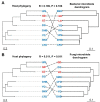Environmental factors and host genotype control foliar epiphytic microbial community of wild soybeans across China
- PMID: 36992926
- PMCID: PMC10041966
- DOI: 10.3389/fmicb.2023.1065302
Environmental factors and host genotype control foliar epiphytic microbial community of wild soybeans across China
Abstract
Introduction: The microbiome inhabiting plant leaves is critical for plant health and productivity. Wild soybean (Glycine soja), which originated in China, is the progenitor of cultivated soybean (Glycine max). So far, the community structure and assembly mechanism of phyllosphere microbial community on G. soja were poorly understood.
Methods: Here, we combined a national-scale survey with high-throughput sequencing and microsatellite data to evaluate the contribution of host genotype vs. climate in explaining the foliar microbiome of G. soja, and the core foliar microbiota of G. soja were identified.
Results: Our findings revealed that both the host genotype and environmental factors (i.e., geographic location and climatic conditions) were important factors regulating foliar community assembly of G. soja. Host genotypes explained 0.4% and 3.6% variations of the foliar bacterial and fungal community composition, respectively, while environmental factors explained 25.8% and 19.9% variations, respectively. We further identified a core microbiome thriving on the foliage of all G. soja populations, including bacterial (dominated by Methylobacterium-Methylorubrum, Pantoea, Quadrisphaera, Pseudomonas, and Sphingomonas) and fungal (dominated by Cladosporium, Alternaria, and Penicillium) taxa.
Conclusion: Our study revealed the significant role of host genetic distance as a driver of the foliar microbiome of the wild progenitor of soya, as well as the effects of climatic changes on foliar microbiomes. These findings would increase our knowledge of assembly mechanisms in the phyllosphere of wild soybeans and suggest the potential to manage the phyllosphere of soya plantations by plant breeding and selecting specific genotypes under climate change.
Keywords: core microbiome; foliar microbiome; host genotype; microbial community assembly; wild soybean.
Copyright © 2023 Zhou, Duan, García-Palacios, Yang, Cui, Yan, Yin, Yi, Li, Delgado-Baquerizo and Zhu.
Conflict of interest statement
The authors declare that the research was conducted in the absence of any commercial or financial relationships that could be construed as a potential conflict of interest.
Figures






References
-
- Albino U., Saridakis D. P., Ferreira M. C., Hungria M., Vinuesa P., Andrade G. (2006). High diversity of diazotrophic bacteria associated with the carnivorous plant Drosera villosa var. villosa growing in oligotrophic habitats in Brazil. Plant Soil 287, 199–207. doi: 10.1007/s11104-006-9066-7 - DOI
LinkOut - more resources
Full Text Sources

